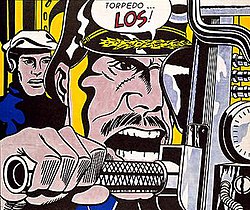This article or section is in a state of significant expansion or restructuring. You are welcome to assist in its construction by editing it as well. If this article or section has not been edited in several days, please remove this template. If you are the editor who added this template and you are actively editing, please be sure to replace this template with {{in use}} during the active editing session. Click on the link for template parameters to use.
This article was last edited by TonyTheTiger (talk | contribs) 13 years ago. (Update timer) |
Torpedo...Los! is a 1963 oil on canvas painting by Roy Lichtenstein. When it last sold in 1989, The New York Times described the work as "a comic-strip image of sea warfare".[1] Like many of Lichtenstein's works it's title comes from the speech balloon in the painting. The source of the image is "Battle of the Ghost Ships?" in D.C. Comics' Our Fighting Fources, no. 72 (October 1962) although the content of speech balloon is different.[2]
| Torpedo...Los! | |
|---|---|
 | |
| Artist | Roy Lichtenstein |
| Year | 1963 |
| Type | Pop art |
On November 7, 1989 Torpedo...Los! sold at Christie's for $5.5 million (US$14 million in 2025 dollars[3]) to Zurich dealer Thomas Ammann, which was a record for a work of art by Lichtenstein.[1] The sale was described as the "highpoint" of a night in which Christie's achieved more than double the total sales prices of any other contemporary art auction up to that date.[4] The seller of the work was Beatrice C. Mayer, the widow of Museum of Contemporary Art, Chicago founder and board member Robert B. Mayer as well as daughter of Sara Lee Corporation founder Nathan Cummings.[5][6] Torpedo...Los! was expected to sell for $3 to 4 million at the time.[5] Prior to the sale the work was part of the Robert B. Mayer Memorial Loan Program and was exhibited at colleges and museums.[5] In 1991, Mayer became one of the key benefactors of the new Museum of Contemporary Art Building.[7]
According to the Lichtenstein Foundation website, Torpedo...Los! was part of Lichtenstein's second solo exhibition at Leo Castelli Gallery from September 28 — October 24, 1963 that included Drowning Girl, Baseball Manager, and Whaam!.[8] Although most of Lichtenstein's war imagery depicts American war themes, this depicts "...a scarred German submarine captain at a battle station..."[9] He is a World War II Nazi commander. The manner of depiction with the commander's face pressed against the periscope reflects fusions of industrial art of the 1920s and 1930s.[10] By enlarging the face of the captain relative to the entire field, Lichtenstein makes him more prominent.[2] He retained the "clumsiness" of the secondary figure and replaced the dialogue with a much shorter "cryptic command".[2]
Notes
- ^ a b Reif, Rita (1989-11-09). "A de Kooning Work Sets A Record at $20.7 Million". The New York Times. Retrieved 2012-05-09.
- ^ a b c Waldman, Diane (1993). Roy Lichtenstein. Solomon R. Guggenheim Museum. pp. 96&ndadsh, 97. ISBN 0-89207-108-7.
- ^ 1634–1699: McCusker, J. J. (1997). How Much Is That in Real Money? A Historical Price Index for Use as a Deflator of Money Values in the Economy of the United States: Addenda et Corrigenda (PDF). American Antiquarian Society. 1700–1799: McCusker, J. J. (1992). How Much Is That in Real Money? A Historical Price Index for Use as a Deflator of Money Values in the Economy of the United States (PDF). American Antiquarian Society. 1800–present: Federal Reserve Bank of Minneapolis. "Consumer Price Index (estimate) 1800–". Retrieved February 29, 2024.
- ^ Reif, Rita (1989-12-06). "Art Prices Are Still Astonishing, But Fever Seems to Be Cooling". The New York Times. Retrieved 2012-05-09.
- ^ a b c Reif, Rita (1989-11-03). "Auctions". The New York Times. Retrieved 2012-05-09.
- ^ Gillespie, Mary (1991-01-29). "Donors cite need for new art museum". Chicago Sun-Times. Retrieved 2009-08-23.
- ^ Gillespie, Mary (1991-01-29). "Trustees endow success of a new art museum". Chicago Sun-Times. Retrieved 2009-08-23.
- ^ "Chronology". Roy Lichtenstein Foundation. Retrieved 2012-05-09.
- ^ Coplans, John, ed. (1972). Roy Lichtenstein. Praeger Publishers. p. 40.
- ^ Hendrickson, Janis (1993). "The Pictures That Lichtenstein Made Famous, or The Pictures That Made Lichtenstein Famous". Roy Lichtenstein. Benedikt Taschen. p. 38. ISBN 3-8228-9633-0.
The Nazi commander of Torpedo...Los! (Ill. p. 20)(1963) refers more definitely to the Second World War. In the superficial world of the comics, only an enemy could have a scar and eyebrows like that. As in so many of Lichtenstein's paintings showing human comic figures, the face has been blown up to an overwhelming size and become a main element in the composition. Perhaps the way it has been pressed up against the telescope, uniting man and machine, was meant to recall such fusions in the industrially-orientd art of the twenties and thirties.